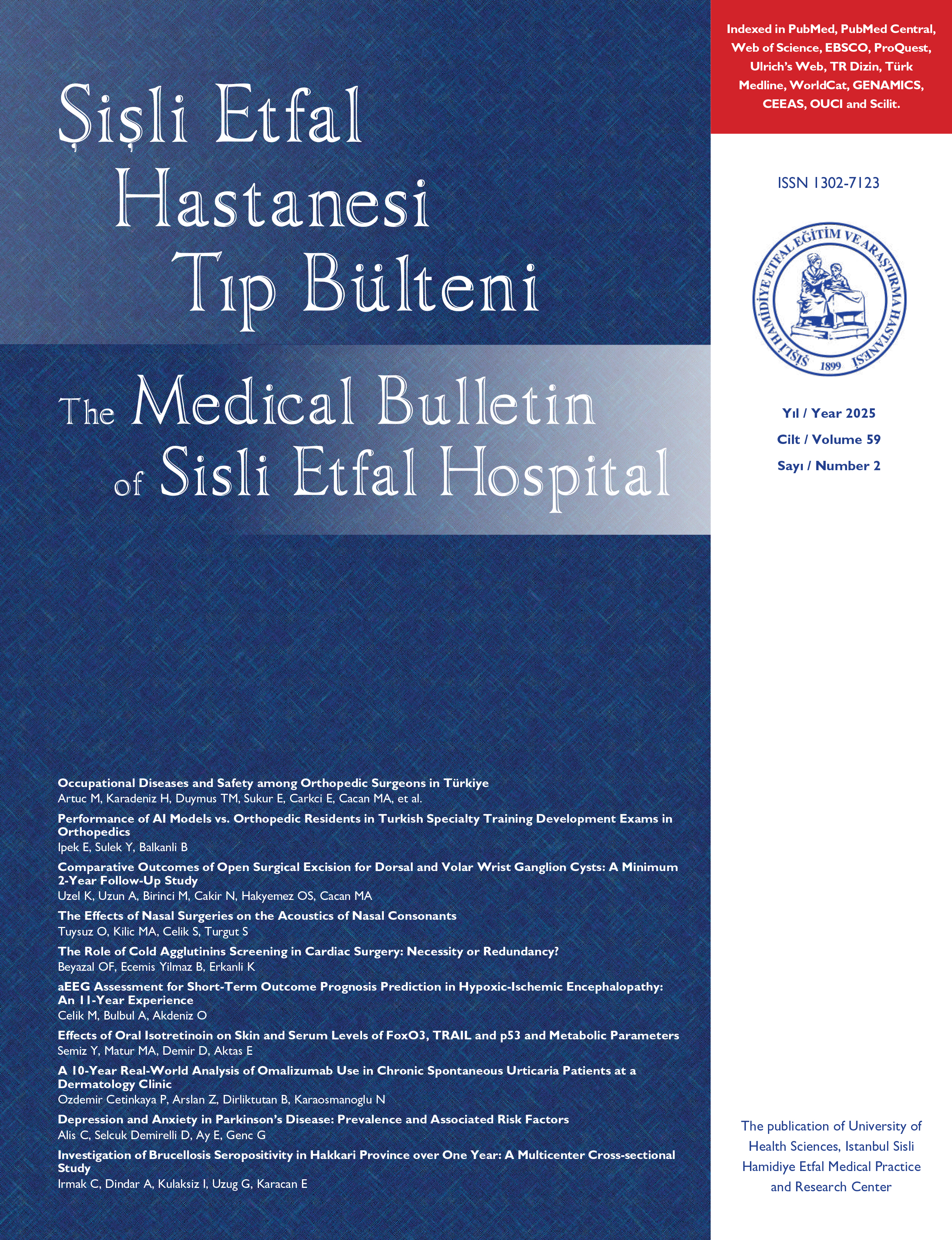
Mide Kanserinde Genel Sağkalım Tahmininde Preoperatif Bilgisayarlı Tomografi Özelliklerinin Önemi: Retrospektif Bir Analiz
Inci Kizildag Yirgin1, Izzet Dogan2, Sezai Vatansever3, Sukru Mehmet Erturk41İstanbul Üniversitesi, Onkoloji Enstitüsü, Radyoloji Ana Bilim Dalı, İstanbul2Basaksehir Cam ve Sakura Hastanesi, Onkoloji Ana Bilim Dalı, İstanbul
3İstanbul Üniversitesi, Onkoloji Enstitüsü, Tıbbi Onkoloji Ana Bilim Dalı, İstanbul
4İstanbul Üniversitesi, İstanbul Tıp Fakültesi, Radyoloji Ana Bilim Dalı, İstanbul
Amaç: Bilgisayarlı tomografi (BT), mide kanserinin preoperatif değerlendirilmesinde evrelemede sıklıkla kullanılan bir yöntemdir. Amacımız, mide kanseri nedeniyle ameliyat edilen hastalarda preoperatif BT bulgularının genel sağkalımı (OS) öngörmedeki rolünü değerlendirmektir.
Materyal-Metod: Ameliyat öncesi BT çekilen 101 mide kanseri hastası (68 erkek, 33 kadın; yaş aralığı, 29-82 yıl; medyan, 61 yıl) retrospektif olarak değerlendirildi. İki radyolog, tümörün invazyon derinliğini (T evresi), patolojik lenf nodlarının sayısını (N evresi), lezyonun en uzun çapını, tümörün lokalizasyonunu ve tümörün arteriyel ve venöz fazlardaki dansite değerlerini ölçmek için multiplanar rekonstrüksiyon görüntülerini değerlendirdi. Postoperatif patoloji bulguları, rezeksiyon durumu (R0, R1), patolojik T evresi, N evresi, derece, histopatolojik alt tipi kaydedildi. BT kaynaklı tüm parametreler ve OS ile ilişkili klinikopatolojik değişkenler tek değişkenli analiz ile analiz edildi, bunu çok değişkenli ve alıcı operatör özellikleri (ROC) analizi izledi.
Bulgular: Çok değişkenli cox regresyon analizi, preoperatif BT bulgularının hiçbirinin OS ile ilişkili olmadığını gösterdi. Rezeksiyondan sonra, sağkalım oranı R1 ve yüksek gradeli gruplarda R0 ve düşük gradeli gruplardan daha kötüydü (sırasıyla p: 0.001, p: 0.005). BT görüntülemede N evresi ile lezyonun en uzun çapı ve R1 rezeksiyonu doğru bir şekilde öngördü (sırasıyla AUC, 0.697; duyarlılık, %63; özgüllük, % 88, AUC,0.734; duyarlılık, % 18; özgüllük, % 76).
Sonuç: R1 rezeksiyon ameliyat edilen mide kanserinde daha düşük OS ile ilişkilidir. Tümörün uzun çapı ve patolojik lenf nodu sayısı da dahil olmak üzere BT bulguları R1 rezeksiyonunu öngörebilir. (SETB-2022-08-187)
The Significance of Preoperative Computed Tomography Features in the Prediction of Overall Survival in Gastric Cancer: A Retrospective Analysis
Inci Kizildag Yirgin1, Izzet Dogan2, Sezai Vatansever3, Sukru Mehmet Erturk41Department of Radiology, Oncology Institute, Istanbul University, Istanbul, Türkiye2Department of Medical Oncology, Basaksehir Cam ve Sakura Hospital, Istanbul, Türkiye
3Department of Medical Oncology, Oncology Institute, Istanbul University, Istanbul, Türkiye
4Department of Radiology, Istanbul Medical Faculty, Istanbul University, Istanbul, Türkiye
Objectives: Computed tomography (CT) is a frequently used modality for staging in the preoperative evaluation of gastric cancer (GC). Our aim was to interpret the importance of preoperative CT features in predicting overall survival (OS) in patients operated for GC.
Methods: One hundred and one patients with GC (33 women, 68 men; range of age: 2982 years, median age: 61 years) who had abdominal CT prior to surgical resection were included in the study retrospectively. Two radiologists evaluated CT scans to record the longest dimension of the tumor, the localization of the lesion, the attenuation values of the tumor in the arterial and venous phases (Hounsfield units), invasion depth of the lesion (T stage), and the number of pathological lymph nodes (LNs) (N stage). Postoperative pathological results including resection (R0, R1), T stage, N stage, grade, and histopathological subtype were documented. All CT-provided results and clinicopathological features associated with OS were analyzed by univariate, multivariate, and receiver operator characteristic analysis.
Results: Multivariate analysis revealed that none of the CT features were associated with the OS. After resection, the survival ratio was poor for the R1 and high-grade groups than for the R0 and low-grade groups (p=0.001 and p=0.005, respectively). N stage and the longest dimension of the tumor on CT imaging truly estimated R1 resection status (AUC, 0.697; sensitivity, 63%; and specificity, 88%, and AUC, 0.734; sensitivity, 18%; and specificity, 76%, respectively).
Conclusion: R1 resection status is associated with poor OS in GC. CT features, including the tumors longest dimension and the number of pathological LNs, can predict R1 resection status.
Makale Dili: İngilizce



















